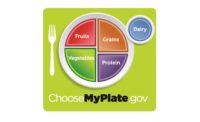The United States Department of Agriculture (USDA) and the United
States Department of Health and Human Services (HHS), both in
Washington, D.C.,
released the 2010 Dietary Guidelines, which is designed to help
Americans make healthier food choices and confront the obesity epidemic.
Selected messages for consumers include enjoy the food but eat less, avoid oversized portions, make half the plate fruits and vegetables, compare sodium amounts, and more.
The revised guidelines also advise Americans to balance calories to manage weight, build healthy-eating patterns, monitor calorie and fat intake, incorporate more exercise and encourage retailers, schools and employers to provide a healthy-eating environment and create nutrition-related programs, among other topics.
“The 2010 Dietary Guidelines are being released at a time when the majority of adults and one in three children is overweight or obese, and this is a crisis that we can no longer ignore,” says agriculture secretary Tom Vilsack. “These new and improved dietary recommendations give individuals the information to make thoughtful choices of healthier foods in the right portions and to complement those choices with physical activity. The bottom line is that most Americans need to trim our waistlines to reduce the risk of developing diet-related chronic diseases. Improving our eating habits is not only good for every individual and family, but also for our country.”
One such category impacting the bakery market is refined grains. The recommended amount of refined grains is no more than 3-oz. equivalents per day, according to the new guidelines. “Refined grains should be replaced with whole grains, such that at least half of all grains eaten are whole grains. Consumption of refined grain products that also are high in solid fats and/or added sugars such as cakes, cookies, donuts and other desserts should be reduced,” the guidelines state. Major sources of refined grains are yeast breads (26%), pizza (11%), grain-based desserts (10%) and tortillas, burritos and tacos (8%).
The discussion of fiber intake also played a part in the revised guidelines. According to the report, the recommended daily value of fiber is 14 g. per 1,000 calories, or 25 g. per day for women and 38 g. per day for men. “Most Americans greatly under-consume dietary fiber, and usual intake averages only 15 g. per day,” the report says. “Breads, rolls, buns and pizza crust made with refined flour are not among the best sources of dietary fiber, but currently contribute substantially to dietary fiber consumption because they are ubiquitous in typical American diets. To meet the recommendation for fiber, Americans should increase their consumption of beans and peas, other vegetables, fruits, whole grains and other foods with naturally occurring fiber. Whole grains vary in fiber content.”
The updated report also reaffirms the importance of enriched and whole grains as the foundation of a healthy lifestyle.
That’s why bakers continue to offer innovative, healthy grain products to meet customers’ needs. These include an ever-growing variety of whole grain products and other items that meet consumer preferences, including calcium for bone health, breads fortified with Omega-3s and lower sodium bakery products. Enriched grains are the source of eight essential nutrients such as folic acid, B vitamins, iron and fiber. According to Atlanta-based U.S. Centers for Disease Control and Prevention (CDC), folic acid is essential for expectant mothers and may also reduce the risk of heart disease and stroke in adults. Since folic acid fortification of enriched grains was implemented in 1998, neural tube birth defects have dropped 25-35%.
“The American Bakers Association applauds the 2010 Dietary Guidelines for Americans that provide important tools to improve the health of all Americans and combat the obesity epidemic. Grain foods are the foundation of a healthy lifestyle since complex carbohydrates provide essential fuel the body needs,” says Robb MacKie, president and CEO of the American Bakers Association (ABA), Washington, D.C. “ABA also strongly supports the 2010 guidelines’ recommendation for physical activity and believes that exercise is an essential component of a healthy lifestyle, regardless of age. By encouraging Americans of all ages to engage in a variety of enjoyable physical activities that are age and health appropriate, we believe exercise will improve the health of our country.”
The 2010 Dietary Guidelines were composed by a committee of scientific experts who reviewed and analyzed the most current information on diet and health and compiled their findings into a scientific, evidence-based report. The goal of the Dietary Guidelines is to put this knowledge to work by facilitating and promoting healthy eating and physical activity choices, with the ultimate purpose of improving the health of all Americans.
To learn more about the Dietary Guidelines or to read the report, go to www.dietaryguidelines.gov.
Related Articles
Related Products
See More ProductsSee More ProductsEvents
View AllSubmit An Event-
March 1, 2010 Food Plant of the Future: Advancing Food Safety through Sanitary Design
-
September 9, 2010 Food Plant of the Future: Surviving and Thriving with Automation
×
Get our new eMagazine delivered to your inbox every month.
Stay in the know on the latest snack and bakery industry trends.
SUBSCRIBE TODAY!Copyright ©2024. All Rights Reserved BNP Media.
Design, CMS, Hosting & Web Development :: ePublishing




